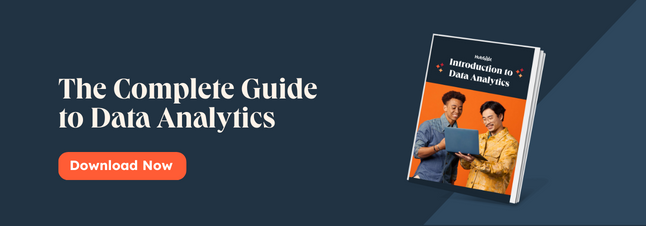Data Warehousing Concepts: What Is a Data Warehouse?
A data warehouse is a business intelligence system that brings together large volumes of data from multiple sources into a centralized repository for more efficient organization, analysis, and reporting. Sources could include website data capturing tools, purchases and transactions, inventory tracking systems, an enterprise resource planning system (ERP), and marketing and sales software.
The main job of a data warehouse is to synthesize the high amount of data produced by all of a business’s systems into one accessible location. In a data warehouse, information flows in continuously while analysts review it. This makes it possible for businesses to create reports and dashboards that continuously monitor and improve business functions.
.webp?width=650&height=300&name=what%20is%20a%20data%20warehouse%20(update).webp)
Data warehouses are not a new concept, but have grown more sophisticated with the rise of cloud technologies. From low-level to high-level, a data warehouse usually includes a database to hold the raw data, software to extract data from the database and prepare it, and tools for analysis, reporting, and data visualization. A data warehouse may also apply advanced AI and machine learning techniques.
What are the benefits of a data warehouse?
The main purpose of a data warehouse is to aggregate a business’s data assets into a single source of truth for analysis and insights, instead of requiring analysts to track down data from dozens of siloed sources. Additional benefits include:
- More actionable information: A data warehouse not only compiles large volumes of data, but also facilitates analysis and reporting to help end-users identify big-picture trends and make decisions rooted in the data.
- Improved data integrity: Having all your data in one place is a good start, but it’s not worth much if you’re working with inaccurate data. A data warehouse works to standardize and clean its data, so you can be sure you’re dealing with reliable information.
- Real-time data: Data warehouses update in real time for the most accurate picture of your business.
- Improved performance: Data warehouses are designed to handle very large datasets without lag time or impact on the rest of a company’s technology infrastructure. Data warehouses can manipulate data very quickly, even as data volume scales up.
- AI: Data warehouses are capable of integrating artificial intelligence and machine learning with their datasets to uncover hidden patterns via data mining. AI is a major competitive advantage as it becomes more widely adopted in business intelligence.
For more explanation on data warehouse concepts, check out this video from 365 Data Science that covers its additional defining features:
Data Warehouse vs. Database
It’s important to note that data warehouses are different from databases. While both store data, their purposes differ significantly.
Databases are structures that organize data into rows and columns making the information easier to read. Compared to data warehouses, databases are simple structures intended for storage only.
Data warehouses consist of likely many databases. A data warehouse goes beyond a simple database by compiling data from multiple sources and allowing for data analysis. Data warehouses don't just store data — they aggregate it for long-term business use.
Data Warehouse vs. Data Lake
You may have also heard of “data lakes.” A data lake also stores raw data from different sources, but this data hasn’t been filtered or structured. When businesses keep a data lake, they usually intend to use this data later in a more structured manner.
Data warehouses, on the other hand, store structured data that has been filtered, cleaned, and defined for a specific use. Data warehouses are made for analysis and extracting insights, as the data they contain is much more actionable.
Because data lakes include raw data, the data is simpler to use and easier to edit. In data warehouses, the data is more expensive to make changes to, but better for long-term decisions.
%20(1).webp?width=650&height=393&name=what%20is%20a%20data%20warehouse%20(update)%20(1).webp)
Types of Data Warehouses
Enterprise Data Warehouse
Enterprise data warehouses are central databases where data is organized, classified, and used for decision-making. These systems will also label data and categorize it for easier access.
Operational Data Store
While an enterprise data warehouse is better for long-term business decisions, an operational data store (ODS) is preferred for daily, routine activities. ODS is updated in real-time and stores data specific to a chosen activity.
Data Mart
A data mart is a part of a data warehouse that supports a specific business department, team, or function. Any information that passes through a data mart is automatically stored and organized for later use. A data mart has the same benefits and functions as a data warehouse, just on a smaller scale.
Now that you're familiar with the fundamentals of data warehouses, let's take a look at some common concepts used by most businesses.
3 Data Warehouse Concepts with Examples
Basic Data Warehouse
A basic data warehouse aims to minimize the total amount of data that is stored within the system. It does this by removing any redundancy within the information, making it clear and easy to look through.
As you can see in the example below, this concept centralizes information from a variety of sources. Employees then access data directly from the warehouse. This system is useful for SMB who want a simple approach to data storage.
-3.webp?width=650&height=477&name=what%20is%20a%20data%20warehouse%20(update)-3.webp)
Data Warehouse With Staging Area
Some data warehouses clean and process data before moving it into storage. These systems have "staging areas" where information is reviewed, evaluated, then deleted or transferred into the warehouse. This ensures that only relevant and useful data are stored within the software.
If you look at the example below, you can see that the staging area is placed between the data sources and the warehouse. For businesses that process large amounts of customer data, this process will filter out irrelevant information that isn't beneficial to your team.
-1.webp?width=650&height=484&name=what%20is%20a%20data%20warehouse%20(update)-1.webp)
Data Warehouse With Data Marts
Data marts add another level of customization to your data warehouse. Once data is processed and evaluated, data marts streamline information to teams and employees who need it most. That makes your departments significantly more productive because customer data is being delivered directly to them.
In the example below, we can see how data marts are used to send information to Sales and Inventory teams. This helps business leaders make faster decisions and capitalize on timely marketing opportunities.
-2.webp?width=650&height=422&name=what%20is%20a%20data%20warehouse%20(update)-2.webp)
Data Warehouses: Keep Data Up-to-date
A staple of business intelligence systems, a data warehouse presents numerous benefits to scaling companies. If your enterprise is facing challenges managing large amounts of date and distributing throughout your team — while also struggling to leverage this data for meaningful insights — a data warehouse may be your best option.
Editor's note: This post was originally published in August 2019 and has been updated for comprehensiveness.











